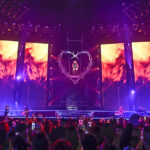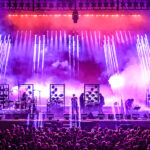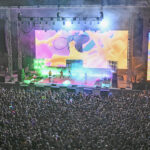
It’s been 25 years since Third Eye Blind’s first catchy hit single, “Semi-Charmed Life” hit the airwaves. The rock band has racked up more hits since then and has become a staple on the touring scene. They celebrate that quarter-century on their Summer Gods: 25 Years in the Blind tour, crisscrossing the U.S. with Taking Back Sunday and opener Hockey Dad. Solotech is providing lighting, audio, and video. Gallagher Staging and Productions constructed the set and staging, and I Love Lasers is supplying the lasers.
Lead singer Stephan Jenkins formed Third Eye Blind—which could refer to our third eye chakra—in 1993 in San Francisco. While band members have come and gone, he takes the helm when it comes to how their show is viewed by the fans.

It Starts with Sticks
The tour’s production design started with a photo, a scene from nature. Band frontman Jenkins sent a photo to Kyle Wood, the band’s longtime production manager. Wood commissioned Chris Denholm, production and lighting designer of Partner Production Services, to build a show around it.
“I’m not sure if he saw it in a park or was traveling, but he wanted to create this cage-like structure of an organic nature,” Denholm explains. “He wanted everything to look like it was part of nature. That was the starting place.”
Denholm approached Gallagher Staging and Productions in Nashville for help sourcing twigs. “Gallagher bought a wide range of decorative sticks. We bought three or four different versions and put together pictures for Stephan to view and make sure it was right.”

Gallagher’s James McKinney describes the process of sourcing the tree limbs for the set. “The ‘Stick’ look was very important, but they did not want it to look completely uniform or too cluttered. We experimented with different combinations of different sized limbs and twigs to get to the look that the band wanted.” McKinney recalled a previous project in which they had used some birch logs in a scenic piece, so he reached out to the same company to see what they may could conjure up.
“The company goes into the woods in northern Maine and harvests these pieces based upon each order,” he says. “They were able to source ‘straight’ birch poles, alder forked limbs, and birch twigs. Then they take care to make sure they are clean and kiln-dried to kill any bugs and disease they may contain before shipping. Once we received the poles, branches, and twigs, we then applied a fire retardant to them to make sure there were no issues on tour with local fire codes.”
“They did a great job with it,” Denholm jumps in. While Kyle Wood is production manager on this tour, Denholm’s experience as a PM led him to ensure his design would check all the boxes: road-worthy, packable and cost-effective. “Dreams have to meet reality—it has to pack in a truck and travel,” he points out. To make it feasible—”without doing a whole bunch of fabrication and spending a million dollars on set design”—Denholm reached out to Solotech for their prefabricated pod structures, then asked Gallagher Staging to use the final approved sticks to create what he called “a set within the pods” so that he could backlight the pod structures.
The result, and the centerpiece of the show, was a set with tall rectangular panels—or pods—and risers, all outfitted with 300 straight birch limbs, 200 forked alder limbs, and 150 multi-branched birch twigs.

The eight large pods, composed of rectangular aluminum frames, are positioned upstage. Each pod is made up of four individual quadrants filled with lighting fixtures and enhanced with the natural stick decor within it. “The complete pods roll into the truck pack four wide, and the sticks live inside of it, so they don’t have to mess with it.”
He adds, “That is the beauty of knowing the logistics side. Not only am I thinking about how it will look, but how it will operate. It’s no good if you can’t set it up in four hours and tear it down in two.”
The pods don’t move. But there is lots of flexibility, he adds, and the pods’ endless modularity allows them to be fully flexible to have the largest show possible each night, regardless of venue size.
“The upstage stick pods are flown off of one truss that will trim between 27’ to-30’. The four fingers, extending 24’ from the upstage pods, are built of three eight-foot trusses and raked at 30˚. The daily trim height dictates the rake angle to cover the negative space—more trim should mean more rake and larger looks. So, eight-foot sections of truss can be eliminated or added without affecting the integrity of the design. Additional stick pods could be removed from overhead as well.”

‘All Silhouette’ Band
At this point, the Denholm puts on his LD cap and shifts the conversation into lighting fixtures, providing more details on the pods.
There are four GLP impression X4 Bar 20s in each pod—basically, one in the center of each quadrant in the pod. “It’s the most sought-after fixture right now,” he says about the LED product. “It’s beautiful, creates a wall of light and you can do pixelated programming with it; it is what sets off those pods.”
Each large pod also features two Martin VDO Sceptrons recessed in each quadrant, for a total of eight per pod, The Sceptrons, which are LED lighting/video battens, are positioned in between the GLP X4 Bar 20s. They backlight the sticks in the set, which take the texture of the gnarly twigs well. They are also fed with content from a Resolume laptop, run by Lighting Operator, Conner Ostrowski.
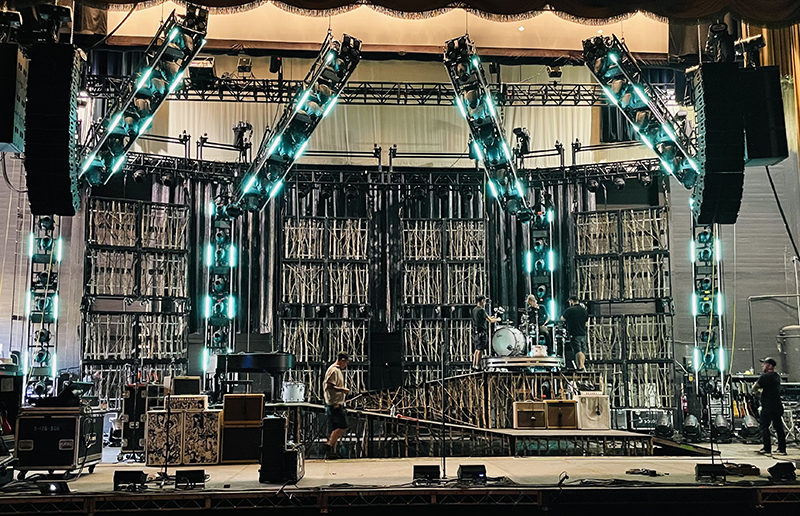
The Robe Pointes and MegaPointes are the workhorses of the rig. “MegaPointe is such a great fixture,” Denholm notes, saying he’s positioned the fixtures strategically above the pods. “There is a truss you have to use to rig the pods, so that gives opportunity for key light and other big looks with those fixtures.”
A line of Chroma-Q Color Force II 72 LED lighting fixtures are positioned in the upstage to backlight the pods. “It creates almost like a sunset behind the sticks,” he notes.
The four sticks of truss above the pods are highlighted with four Martin MAC Quantum Wash fixtures at each tail end on the upstage side. This is how he “sneaks in lighting” for bands, such as Third Eye Blind, who prefer minimal light. “This is an ‘all-silhouette’ band—they don’t want front light but rather minimal lighting, so those fixtures are snuck in there and it allows us to backwash and wash the whole stage and create silhouette looks,” he explains. “They are kind of hidden in the back of the four upstage trusses.”
It’s his “little trick” he uses to light artists who don’t want to be lit. “They don’t want to be lit up like they’re sitting in a dentist chair, but you have to find a way to light up artists so they can be visible but also in a way that they like. That is a challenge I see with almost all my artists. Most of the artists I work with want that silhouette look for a more mysterious feel. Almost every artist wants to be ‘lit but not lit.’ Part of the gig is to find solutions,” the designer explains.
Another part of that solution is using Elation Professional Colour Chorus 12, which offer strobe and chase effects and variable dimming curves, to uplight the front of the band. “That was the compromise to create some sort of shadows or silhouette or front light, so they sprinkle a minimum amount of light.”
He likes the features of the TMB Solaris Flare and has them scattered throughout the truss. “Third Eye Blind is a live show, no tracks, so what is a rock and roll show without strobe effects? I love the Solaris Flare, and the pixelated programming you can do. It’s a powerful LED strobe.”

Hybrid Programming
Programmer Michael John Gionfriddo says during the programming session he thought it was best to take a “hybrid” approach to the show file. “Conner and I have worked on many shows together and knowing his musicality and operating style would benefit from this approach, it made perfect sense to go that direction.”
Gionfriddo explains, “Each song required its own effects; the GLP X4 Bar 20s and Martin Sceptrons required special attention to create the backbone of the looks. The Sceptrons are controlled via Martin P3 and a Resolume media server allowing for many options. When the song required an organic feel the media server stepped in and gave us that option, and when we wanted the more traditional effects, having DMX control of those pixels via the Martin P3 was amazing.”
Gionfriddo adds that they also have busking executors with effects and bumps for all the fixture types that can be used at any time at the LD’s discretion. ”It is a cued show that is heavily busked on top of that; this allows Conner the ability to roll with the changes from show to show. The rig that Chris designed is able to scale to the different size venues that it would encounter, and having that hybrid type show file only helps us in ensuring the show is as consistent as possible regardless of the version of the rig that is hung each day.”
The tour is not carrying video screens, but instead uses each venue’s in-house setup for I-Mag on either side of the stage.
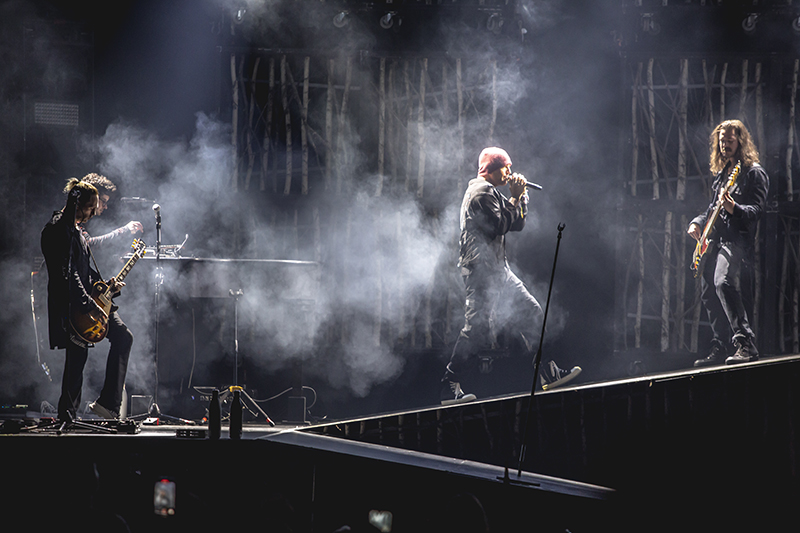
Laser Accents
I Want Lasers, a Los Angeles-based laser and atmospheric effects company, joined the tour as it was already underway, supplying four Kvant Clubmax 10 FB4 lasers, each with the upgraded Saturn Scanning System.
Lighting Operator Ostrowski integrated Pangolin Beyond 5.1 and his MA Lighting grandMA2 so he could have control of the lasers from his console. The lasers were spaced across the upstage mother grid truss, adjusted for each venue depending on the venue’s physical space. “Zoning would be determined by trim and whether or not we had safe places to terminate out into the house—such as back walls, shed roofs and so on,” Ostrowski explains. “Some days we’d shoot all four lasers out into zones in the house, some days all four would be zoned on stage, some days we’d rock two out and two down.”
He used a stock Pangolin content base and then edited most of the clips to make them “a little more of our own,” he says, so they’d be cohesive with the other visual elements of the show. The lasers came into play sparingly, for about five songs of each set. “The set would vary a bit from night to night as they’d rotate some songs in and out. We chose to reveal lasers for the first time at the beginning of ‘Narcolepsy,’ which landed fairly consistently around 11 songs into the usual 26-song set. Our goal while programming all visual elements of this show was to make it as dynamic as possible, and to utilize specialty fixtures like lasers to tastefully accent big moments or groovy licks.”
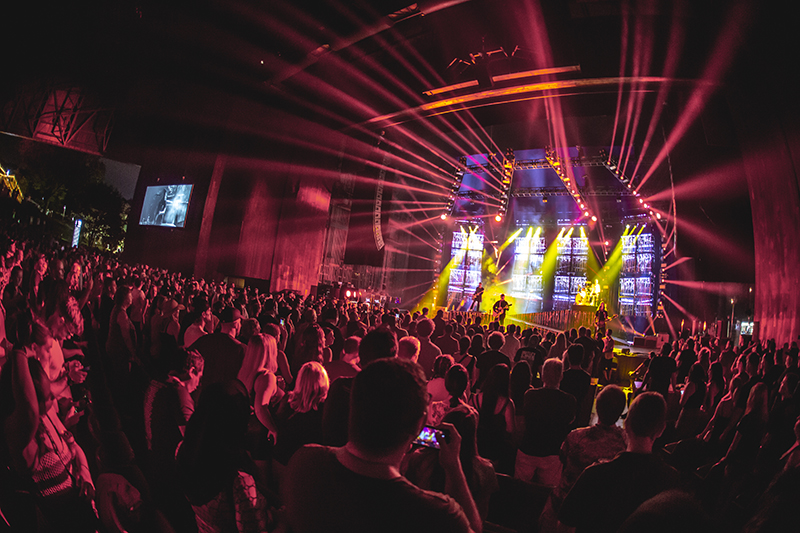
From Page to the Stage
After the tour’s end in mid-August, Denholm took time to reflect on the whole process, a challenge in its combination of natural elements with more traditional lighting structures, and gives credit to Solotech and Gallagher for their expertise. “I was able to lean on some incredible partners during the design and set building process. Solotech and Gallagher coordinated efforts along with Production Manager Kyle Wood to take my design from the page to stage. From a designers’ perspective, I could not have been happier with how both vendors coordinated and the results they provided,” he emphasizes. ”Their partnership was absolutely invaluable from start to finish.”
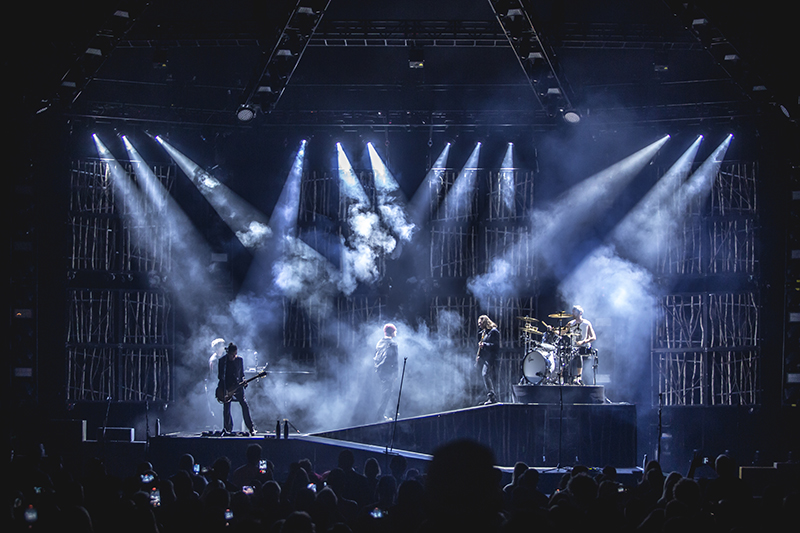
Third Eye Blind Summer Gods Tour 2022
Production Team:
- Lighting & Production Designer Chris Denholm/Partner Production Services
- Production Manager: Kyle Wood
- Lighting Programmer: Michael John Gionfriddo
- Lighting Operator: Conner Ostrowski
- Show Renders & Plots: Dane Kick
Vendors:
- Lighting, Video & Audio Provider: Solotech
- Staging & Set Construction: Gallagher Staging
- Lasers: I Want Lasers
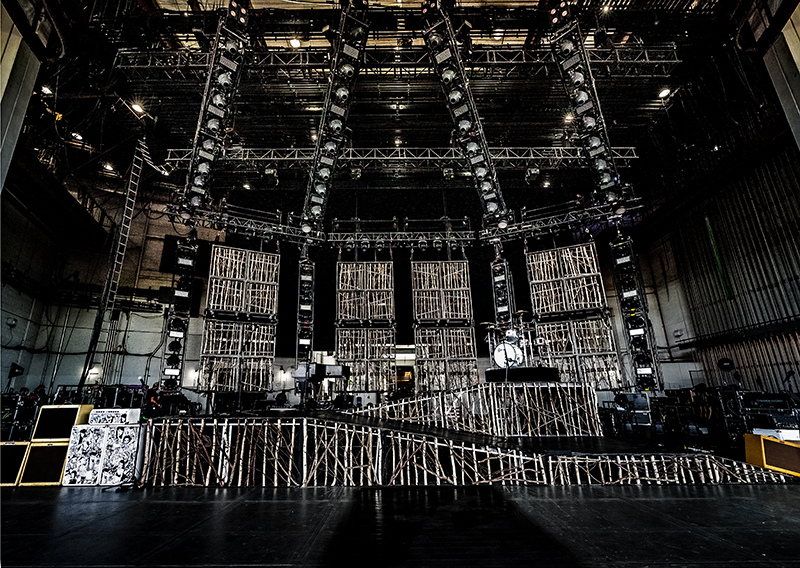
Gear
Lighting
- 1 MA Lighting grandMA3 full-size Console
- 1 MA Lighting grandMA2 light Console
- 5 MA Lighting NPU
- 64 Robe Pointe
- 20 Robe MegaPointe
- 8 Martin MAC Quantum Wash
- 47 GLP impression X4 Bar 20
- 7 Chroma-Q Color Force II 72
- 32 TMB Solaris Flare
- 6 Elation Colour Chorus 12
Video
- 1 Resolume Media Server
- 1 Martin P3-300 System Controller
- 64 Martin VDO Sceptron 10
- 32 Martin VDO Sceptron 10 320mm
Special Effects
- 2 MDG The One Hazer
- 4 Kvant Clubmax 10 FB4 Lasers w/ Saturn Scanning System
